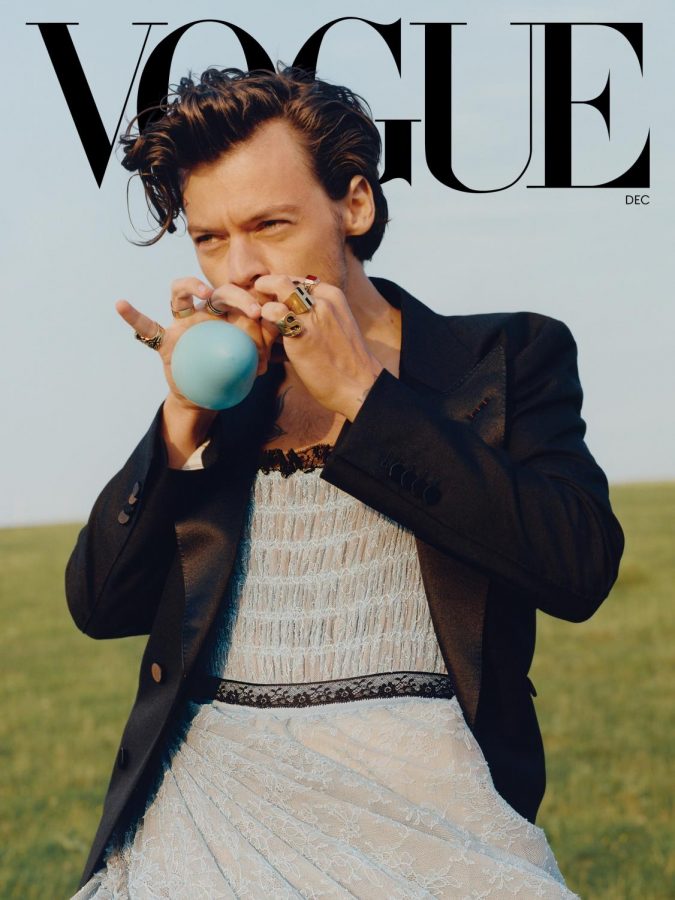Harry Styles: A Musician and Fashion Icon for the New Generation
A bakery. The modern-day legend that is Harry Styles started his rise to stardom in a quaint little bakery located in his hometown, Holmes Chapel. Over the next decade or so, Styles elevated his status as an internationally acclaimed singer, actor, and fashion icon. To cap off a brilliant decade, the England native became the first man to appear solo on the cover of Vogue. And in typical Harry Styles fashion (pun intended), he nearly broke the internet in doing so. On November 13, the magazine was released and received immediate widespread attention. As Styles donned a skirt and gown, many hailed him as a revolutionary icon for gender-fluid fashion. With a powerful fashion selection, Styles demonstrated that there is no place for toxic masculinity in today’s world and no boundaries to define our self-expression.
Harry Styles’s fashion sense has always played an important role in developing his persona (and, of course, his name serves as a perfect complement). As a teenager working in the bakery and receiving his first glimpse of fame, Styles outfits were rather conservative, as he wore typical sweatshirts, polos, blazers, and sneakers or traditional dress shoes. Although this clothing style was nothing extraordinary, it was interesting to note how Styles uniquely layered his clothes – he would often wear blazers on top of polos. This eventually set a foundation for later years and proved to be a critical aspect of his fashion identity.
As Styles embraced his role as boy-band member, his personal style changed accordingly. The sweatshirts, polos, and blazers were replaced with sheer blouses, fuzzy vests, and oversized dress shirts. The sneakers and traditional dress were boring in comparison to the heeled boots that Styles proudly wore to concerts and award ceremonies. During these years, Styles began to publicly dabble with gender-fluid fashion and often wore traditional women’s clothing. As he gained prominence as a pop and rock star, Styles incorporated elements of 1970s rock in his appearance, through his signature long hair and Gucci designed suits.
After One Direction split up, Styles embarked on a solo career and further developed his fashion identity as a result. He maintained certain aspects of his One Direction look by taking them a step further: his suits were more flamboyant (often pink and significantly influenced by Gucci), his heels were taller, and his sweater vests included more playful, color designs. However, Styles took other steps to reach new heights as a champion for gender-fluidity in fashion. He donned baggy high waisted pants, wore pearl necklaces and earrings, and decorated his hands with numerous rings on his fingers. These outfits were often worn in public: a women’s Marc Jacobs suit at the Brit Awards and pearl earrings and painted nails at Met Gala. By demonstrating the gender-fluid nature of clothes, Harry Styles developed his own fashion identity and helped break boundaries.
For many fans of Harry Styles, his stardom and influence comes as no surprise. However, to those who did not repeatedly play “What Makes You Beautiful” or “Sign of the Times,” Styles’s influence has been more of a recent development. The growing “fem-boy” culture on social media apps like TikTok are rooted in the same gender-fluidity movements as Styles’ fashion sense. Beyond the realms of social media and the music industry, Styles has had a tangible impact on youth today. Senior Pavan Eda said, “Harry Styles is awesome because he is a really talented singer and also wears some fire fits. What he taught me is that there is no one thing that I have to restrict myself to. The most important thing is that I feel comfortable in my own skin.”
Although toxic masculinity has shaped societal expectations by teaching men to not go against traditional gender roles, individuals like Harry Styles have helped spark a movement in which those boundaries have less and less meaning. Harry Styles’ influence has not only promoted gender-fluidity in fashion and pushed boundaries of the meaning of masculinity, but also taught individuals to develop and embrace their identities.
Gender-fluidity in the mainstream music industry is nothing new. The ‘80s had eyeliner and fedora-sporting Boy George of Culture Club along with androgynous singers Annie Lennox and David Bowie. Music artist Prince, a pioneer in gender androgyny, embraced his femininity. He wore makeup and heels, and fashioned flamboyant clothing. He transgressed the expectations for masculinity, espousing open expression and vulnerability. Styles’ is representative of a new, more widely-accepted generation of gender-fluid pop artists beating stereotypes. Namely, Korean pop-band BTS members choose to wear non-gender specific clothing, bordering feminine and masculine aesthetics. In an interview with Esquire, BTS vocalist SUGA stated, “There is this culture where masculinity is defined by certain emotions and characteristics. I’m not fond of these expressions.” Embracive of free gender expression, popular music artist Jaden Smith launched his own non-binary fashion line, MSFTStrep in 2016. He, too, is not shy of wearing skirts and nail polish. Styles’s appearance on the cover of Vogue, a magazine dominated by women, proves that femininity does not make a male-identifying individual any less of a man. Furthermore, it is indicative of a greater acceptance of male femininity.
Likewise to blurring lines in gender and fashion, Styles prefers to not label his sexuality. As for Style’s sexual identity, he has stated “I don’t feel like it’s something I’ve ever felt like I have to explain about myself,” in a 2017 interview with The Sun. In a world where speculation surrounds celebrities’ sexualities, Styles has made it clear that one’s sexuality is their own business, and no one else’s. Coming out is a personal process. Styles shows that regardless of public pressure, someone’s labels, or lack thereof, are valid.
Harry Styles’ audience is that of a younger generation, who have grown up with media rife with queerbaiting. Queerbaiting is a marketing technique that hints towards LGBTQ+ themes in movies, TV, and music to falsely draw in an LGBTQ+ audience. Styles’s told TeenVogue, “Am I sprinkling in nuggets of sexual ambiguity to try and be more interesting? No.” From parading Pride flags on stage at concerts to donating merchandise profits to GLSEN (the Gay, Lesbian & Straight Education Network) during Pride month, the “Lights Up” singer has been a vocal advocate for the LGBTQ+ community. Whether or not Harry Styles’ labels his sexuality is of little importance. His sincere love for his fans of all sexualities and open expression of his own sexual fluidity is admirable.
Despite the fact that Harry Styles has been applauded for his Vogue photoshoot, others have taken to social media to voice their traditional opinions. Author Candance Owens tweeted against the feminization of modern men. Her tweet ends with the words “bring back manly men.” Fans quickly defended Styles and his fashion sense.
Throughout history, the definition of what makes a man, a man, has never truly been given a singular name. Society has paid witness to the ever-compelling evolution of men’s fashions, from tights and heavy makeup to frilly blouses to dapper suits to jeans, and so much more. Toxic masculinity involves the cultural pressures for men to behave a certain way— this includes what men should and should not wear. In spite of men’s fluid gender norms across time and culture, toxic masculinity persists. The proverb “clothes do not make the man” holds a universal truth. Younger generations are starting to accept gender fashion androgyny, dispelling the harmful expectations of what a man, and any gender, should look like. Harry Styles on the front cover of Vogue marks a new age for breaking gender stereotypes.
While the music industry has championed breaking gender stereotypes, there is a growing hope that this movement will be a microcosm of a more universal acceptance of fluidity and labels among sexual and gender identities. Acknowledging and embracing these facets of an individual’s overall identity are important steps on the path to self-discovery. And when it comes to self-discovery, in the words of Harry Styles, remember to treat people with kindness.


